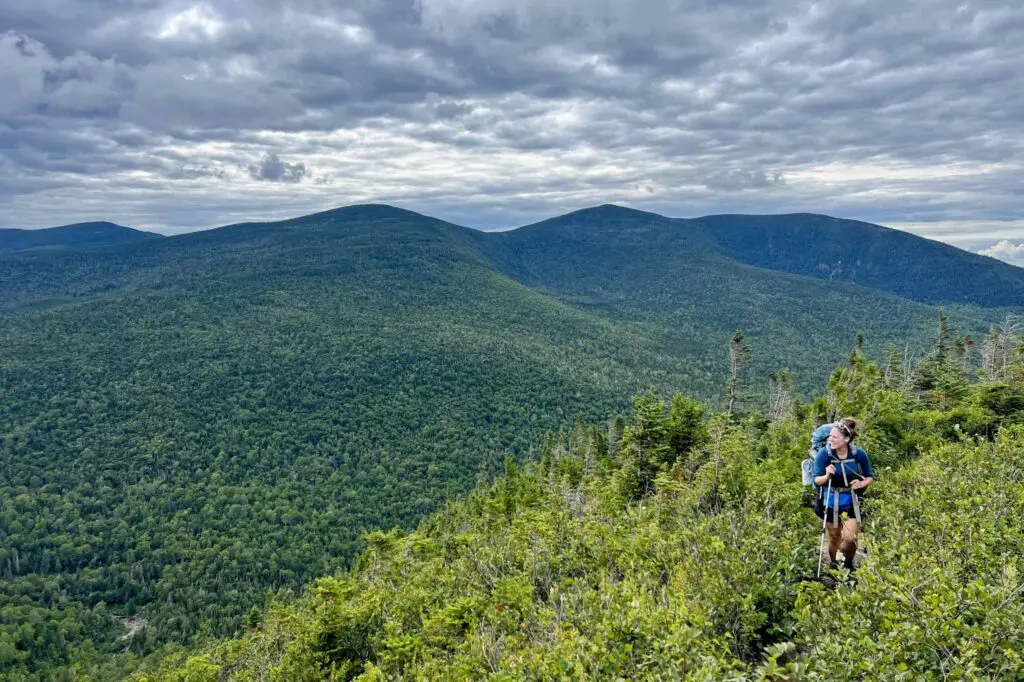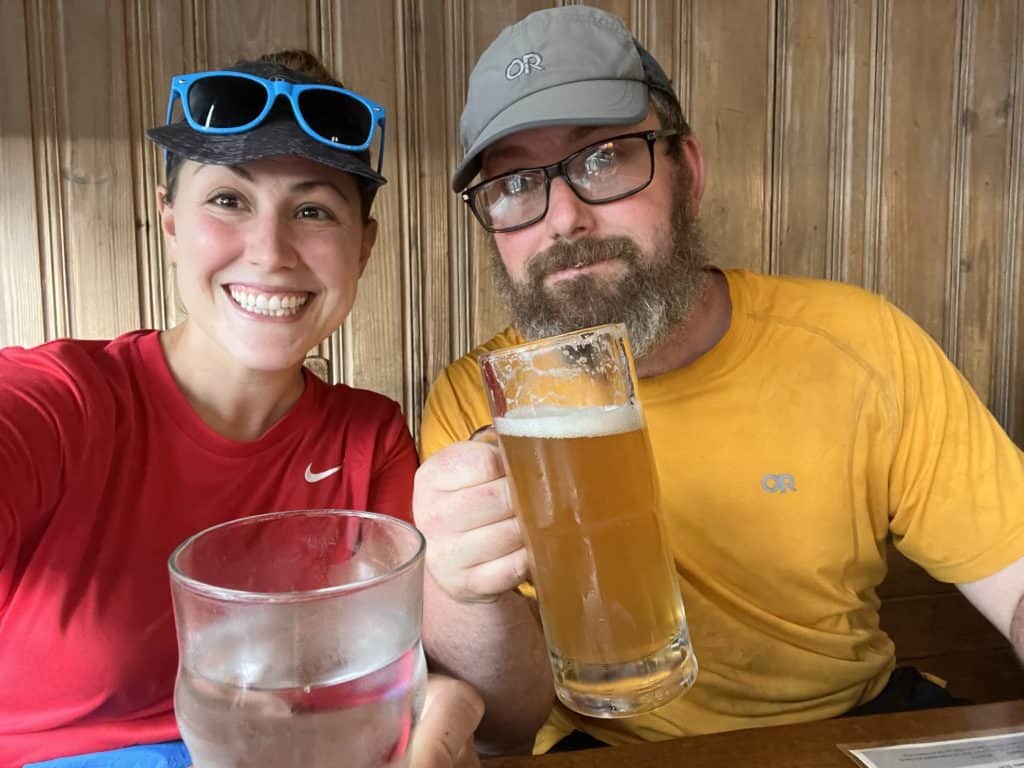

Appalachian Trail Gear Guides for Future Thru-Hikers: A Thru-Hike Backpacking Packing List for 2025
You must be considering a thru-hike of the Appalachian Trail. Congrats! What a badass you are, and what an epic adventure lay ahead.
A few years ago, my husband Barrett and I completed our very own AT thru-hike.

Before our trek, we began researching gear and found the amount of information and gadgets out there wholly overwhelming!
You may be in the same situation right now, especially if you’re a beginner.
This comprehensive Appalachian Trail gear list covers all the gear worth considering to accomplish a thru-hike of the AT.
After tons of research and in-field experience, this article details everything that worked for us (and some things that didn’t).
For every category and item, I’ll explain why it’s worthy of pack space, what to think about when purchasing it, and a quick note on our experience.
Read on to learn how to pack for an Appalachian Trail thru-hike. These posts are designed to equip you with practical, real-world advice, helping you make informed decisions about every piece of gear for a safe and successful hike.
👉 Click here to download the entire Appalachian Trail Gear Checklist for Thru-Hikers.
This document is a comprehensive list covering every essential aspect of outfitting yourself for a thru-hike!
Since we completed our thru-hike as a couple, this post will touch on both female and male gear items. My goal with this guide is to help you start your hike as prepared as possible by sharing our take on what items I believe will serve you best.
I have split this comprehensive packing list into sections, scoll down and jump to what information is most important to you.
Happy gear researching!
The Big Three Essentials
So, let’s jump in and start with the big three essentials: your shelter, sleep system, and backpack.
These are likely the heaviest pieces of gear you’ll have on the Appalachian Trail.
A quick note on the big three: You can cut corners with cheaper options in almost every other category below, but I would not recommend it for the big three.
These are the essential pieces of equipment. Spend the money. You’ll be happy you did.
Quality equipment in these areas kept us chugging along, and will do the same for you.
(PS: If I could add one more item to my “just spend the money” list, it would be shoes.)
I’m going to tell you what we used in each category, but then also list out a few other fan favorites because, let’s face it, everyone’s preferences vary.
Appalachian Trail Shelter Gear
👆 This section compares shelter options for Appalachian Trail thru-hikers and key considerations for choosing a tent, including style (freestanding vs. non-freestanding), season rating (3-season tents are ideal for most hikes), and size (two-person tents are favored even by solo hikers for extra room).
I also review popular tent models, highlighting features like multiple vestibules and efficient weight management, and discuss the importance of using a ground cloth or footprint to protect the tent floor.
Appalachian Trail Sleep System Gear
👆This page focuses on the sleeping system for Appalachian Trail thru-hikers. It examines sleeping bags and sleeping pads and the importance of choosing lightweight and highly functional gear. It also discusses balancing warmth, comfort, and weight when selecting sleeping essentials, ensuring your sleeping setup contributes to a good night’s rest while integrating smoothly with your overall pack.
Appalachian Trail Backpack Gear
👆This page covers backpacks for Appalachian Trail thru-hikers. It explains how to choose the right pack by discussing key factors like capacity, fit, weight distribution, and design features. It focuses on choosing the right pack that balances comfort and weight and selecting a backpack that carries everything efficiently while remaining lightweight. The guide includes advice on features like hip belts, ventilation, and adjustability to ensure hikers stay comfortable over long distances.
Appalachian Trail Clothing Gear
👆This clothing portion advises Appalachian Trail thru-hikers on selecting the right apparel for variable weather conditions. It emphasizes the importance of layering, choosing moisture-wicking fabrics, and ensuring durability to handle the harsh trail environment.
It highlights the need for comfortable, lightweight apparel that adapts to rapidly changing weather conditions, ensuring protection on the trail.
Appalachian Trail Footwear Gear
👆This page focuses on the footwear needs of Appalachian Trail thru-hikers. It covers key considerations for selecting durable, comfortable, and weather-appropriate footwear for long-distance hiking. The guide compares popular shoe and boot options, highlighting the importance of proper fit, support, and the trade-offs between weight and protection to help hikers choose the best option for their journey and optimal performance on long hiking days.
Appalachian Trail Food & Cooking Gear, Water Treatment System
👆This section covers essential food and cooking gear, as well as hydration, for Appalachian Trail thru-hikers. It includes recommendations for backpacking stoves, gas/fuel, and cookware like cups, bowls, mugs, and pots.
It also details safe food storage options like bear bags/canisters and explains the importance of having a reliable water treatment system—featuring a purification filter paired with a water bladder, bottle, or hydration reservoir. Finally, it emphasizes the need for nutritional supplements like electrolytes and energy products to keep you fueled throughout your journey.
Safety & Repair Appalachian Trail Gear Items
👆This section covers a variety of safety and repair tools designed to keep you safe and prepared on the trail. It includes:
- Support & Safety: Trekking poles for balance, a knife/multi-tool for emergency fixes, and pepper spray for personal protection.
- Repair & Maintenance: A first aid kit, sewing kit, gear tape, shoe repair glue, and duct tape to address any gear or injury issues.
These items ensure you’re well-equipped to handle planned and unexpected challenges during your Appalachian Trail adventure.
Appalachian Trail Electronics, Navigation & GPS, Essential Hygiene Items, Less Important Hygiene Items, Bug Management Gear
👆This section covers a wide range of items for trail, grouped into several key categories:
- Electronics & Navigation:
It details must-have gadgets such as your phone, headlamp, battery bank, wall chargers, and a waterproof sack/dry bag. It also emphasizes navigation tools—including AT maps, both paper and digital guidebooks, and a dedicated GPS unit—to help you stay on track. - Hygiene & Toiletries:
The guide lists essential bathroom items like a complete bathroom kit, sunscreen, hand sanitizer, toothbrush, and toothpaste, along with additional personal care products such as soap, floss, deodorant, mirror, hair brush, anti-chafe balm, and wipes. - Bug Management:
It recommends effective bug control solutions, including insect repellent, an insect head net, permethrin insect repellent, and even an EpiPen for emergencies.
Overall, this section ensures you have the right mix of electronics, navigation aids, hygiene products, and bug management gear to keep you connected, healthy, and safe on the Appalachian Trail.
- Electronics
- Navigation & GPS: A.T. Maps, Guidebooks, and Wayfinding
- Essential Hygiene Items / Toiletries
- Less Important Hygiene Items / Toiletries
- Bug Management
Appalachian Trail Luxury Backpacking Items
👆This section features a mix of comfort, convenience, and fun extras to enhance your Appalachian Trail experience. It includes practical items for downtime, unique personal touches like a mascot, gear to capture memories and stay entertained, and more!
Appalachian Trail Gear List FAQs
👆This section compiles key questions about Appalachian Trail thru-hiking, addressing everything from gear needs—such as snow gear, hunting season equipment, and permit requirements—to clarifying backpacking styles (ultralight vs. lightweight). It also explores practical aspects like the typical duration of a thru-hike, whether beginners can successfully complete one, how to prepare, gear rotation frequency, methods for monitoring weather, and the best time to start your journey.
- Appalachian Trail Gear List: FAQs
- What is the Appalachian Trail (AKA the AT)?
- Do you need snow gear for the Appalachian Trail?
- What gear do you need for hunting season?
- Do you need to pack any permits while thru-hiking the Appalachian Trail?
- What does ultralight backpacking vs. lightweight backpacking mean?
- How long does at AT thru-hike take?
- Can someone accomplish a thru-hike of the Appalachian Trail with no experience?
- How can I prepare for the Appalachian Trail?
- How often should I change gear on an AT thru-hike?
- How did you watch for changing weather conditions?
- When should I start the AT?
Pin it for later:

To Sum Up: Appalachian Trail Gear List
That’s it! The exhaustive Appalachian Trail gear list. You, of course, only need some of the items on this list, but everyone is different.
If you want to complete a thru-hike of the AT, use the above information to consider whether or not each object is worthy of your personal pack space and what to think about when purchasing each item.
